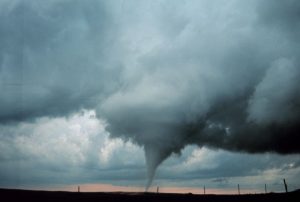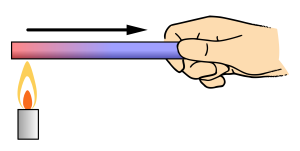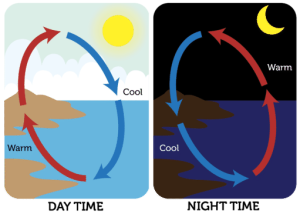5.6 Heat Transfer
Joey Wu
Learning Objectives
- Describe the conduction of thermal energy.
- Explain how convection transfers thermal energy.
- Give an example of the radiation of thermal energy.

It’s hard to see energy moving. But energy is the reason that air moves, and it is sometimes possible to see that. In this photo, differences in temperature are causing air to move—in fantastic ways!
Conduction
Conduction occurs when a temperature difference exists, causing the molecules of an object to transmit energy throughout the object. We usually associate conduction with solids. The atomic structure of a solid is more rigid than a liquid or gas, and thus better able to communicate atomic vibrations caused by heating. Conduction is the transfer of kinetic energy from one molecule to another by molecular collision. Conduction occurs, for example, when a metal spoon is put into a hot cup of tea and the handle of the spoon gets hot.
We mentioned above that some of the food energy we consume is used to maintain a constant body temperature. What happens on a hot day when our body temperature is the same as the outside temperature? No energy will be transferred, since the temperatures are equal and therefore we’ll feel uncomfortably warm since we won’t be able to shed our heat. In contrast, when it is very cold, the temperature difference between our body and the outside temperature can be considerable and thus energy is transferred (rather quickly, if we’re not dressed warmly) from our body to the outside environment. We interpret this rapid transfer of energy as feeling cold.
On a cold day, an object made of metal typically feels colder to the touch than wood, because energy leaves your hand more quickly when touching metal than wood. We say that metal has a higher conduction rate than wood. For example, for the same temperature difference, the conduction rate of copper is over 3,000 times greater than that of wood. Energy will flow from your hand 3,000 times more quickly if you hold a piece of copper, compared to holding a piece of wood of the same temperature. This means, of course, that you don’t want to grab the handle of a copper (or any metal) pot when it’s being heated on your stove. Heat conduction assures that the energy from the flame under the pot is conducted to the handle of the pot and to your hand should you touch it. Ouch!

Figure 1. Heating one end of a metal rod, our hand will feel the other end getting hotter and hotter.
The Direction of Heat Flow
There is a misconception regarding heat flow that we should dispel at this point. Under normally occurring conditions, heat flows only from a hot environment to a cold environment, never in reverse. An open door on a very cold day does not let the cold in. It permits the heat to flow more readily to the outside.
On a cold day, even in a warm room, if you put your hand on a window pane inside your home, it will feel cold. The room temperature may be comfortable, but heat is flowing from the inside of the room to the outside through the glass pane. The air close to the glass pane inside the room has a lower temperature than the average temperature of the room because of its proximity to the outside. Conversely, the layer of air on the outside of the window pane has a higher temperature than the air farther from the window. On windy days, this effect is considerably lessened.
Convection
Convection typically arises from the movement of gases or liquids over large distances. Convection takes place throughout the Earth’s atmosphere all the time. Heated air is less dense than cooler air, so it rises. As the air rises, it cools down and becomes denser. The air then falls back to the ground where it is heated again, and the process repeats. A convection cell, which is a circulating pattern of moving energy, is created. The Figure below shows how the convection cell reverses direction from day to night due to the ground giving off the heat in the evening that it absorbed during daylight hours.
Imagine the air that is heated by the asphalt and the concrete within a city rising, cooling, falling back, and being reheated by the asphalt and concrete, over and over again.
Many atmospheric conditions are the result of convection.

In hot climates, convection is used to cool homes. Ducts within the house provide pathways for the warm air to circulate. As the sun goes down and the temperature drops outside, the warmer air in the house flows through the ventilation ducts and to the cooler environment outside.
Radiation
Both conduction and convection rely upon moving matter. Radiation does not. Radiation is energy transferred by electromagnetic waves (or photons). We will say more about radiation when we discuss the electromagnetic spectrum.
Energy transferred by radiation from the sun travels millions of kilometers through the vacuum of space before reaching the Earth. Some of this energy is visible radiation (sunlight, for example), while other energy is invisible. Heat radiation is an example of invisible radiation. It belongs to a part of the electromagnetic spectrum below the threshold of human sight. Just as there are sounds we cannot hear, there is light we cannot see.
When you sit next to a campfire or a fireplace and feel all warm and cozy, thank radiation! If the only heating we could experience was through convection, we would not be warmed. We would benefit very little from a convection cell up a chimney or directly above a campfire. It is the flow of radiation from the fire that warms us.
Examples
What form of energy transfer is the most likely cause of sunburn?
a. conduction
b. convection
c. radiation
Answer: The answer is C. If it’s a hot day and you touch any metal on a car, you might suffer a burn. This happens through conduction. If you feel a warm breeze, this is through convection. But sunburn is caused by ultraviolet radiation from the sun. As with infrared radiation, ultraviolet radiation is also invisible. It is, however, just above the threshold of human vision. And just as some animals can hear higher frequency sounds than we can (dogs, for example), other animals can see higher frequencies of light than we can (bees can see ultraviolet light).
Key Takeaways
Summary
- Conduction is the transfer of thermal energy between particles of matter that are touching. Thermal energy is always transferred from particles of warmer matter to particles of cooler matter.
- When particles of warmer matter collide with particles of cooler matter, they transfer some of their thermal energy to the cooler particles.
- Convection is the transfer of thermal energy by particles moving through a fluid. Thermal energy is always transferred from an area with a higher temperature to an area with a lower temperature.
- Convection currents move thermal energy through many fluids, including molten rock inside Earth, water in the oceans, and air in the atmosphere.
- Thermal radiation is the transfer of thermal energy by waves that can travel through air or even through empty space. This is how thermal energy from a fire is transferred to your hands and how thermal energy from the sun is transferred to Earth.
- Everything radiates thermal energy, even objects that aren’t very warm.
Retrieved from https://www.ck12.org/book/cbse_physics_book_class_xi/section/10.7/
Media Attributions
- Tornado
- Heat-conduction.svg
- convection

